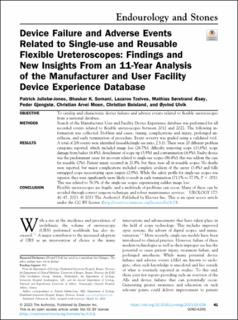Device Failure and Adverse Events Related to Single-use and Reusable Flexible Ureteroscopes: Findings and New Insights From an 11-Year Analysis of the Manufacturer and User Facility Device Experience Database
Juliebø-Jones, Patrick; Somani, Bhaskar K.; Tzelves, Lazaros; Æsøy, Mathias S.; Gjengstø, Peder; Moen, Christian Arvei; Beisland, Christian; Ulvik, Øyvind
Journal article, Peer reviewed
Published version

Åpne
Permanent lenke
https://hdl.handle.net/11250/3109310Utgivelsesdato
2023Metadata
Vis full innførselSamlinger
- Department of Clinical Medicine [2066]
- Registrations from Cristin [9791]
Sammendrag
Objective
To catalog and characterize device failures and adverse events related to flexible ureteroscopes from a national database.
Methods
Search of the Manufacturer User and Facility Device Experience database was performed for all recorded events related to flexible ureteroscopes between 2012 and 2022. The following information was collected: Problem and cause, timing, complications and injury, prolonged anesthesia, and early termination of procedure. Event severity was graded using a validated tool.
Results
A total of 206 events were identified (reusable/single use ratio, 2.5:1). There were 20 different problem categories reported, which included image loss (26.7%), difficulty removing scope (13.6%), scope damage from basket (4.4%), detachment of scope tip (5.8%) and contamination (4.9%). Faulty device was the predominant cause for an event related to single-use scopes (86.4%); this was seldom the case for reusable (2%). Patient injury occurred in 21.8%, but these were all in reusable scopes. No deaths were reported, but major complications included complete avulsion of the ureter (3.4%) and fully entrapped scope necessitating open surgery (2.9%). While the safety profile for single-use scopes was superior, they were significantly more likely to result in early termination (71.1% vs 37.3%, P < .001). This was related to 76.3% of the single-use scopes experiencing sudden image loss.
Conclusion
Flexible ureteroscopes are fragile, and a multitude of problems can occur. Many of these can be avoided through correct surgeon technique and robust maintenance services.
